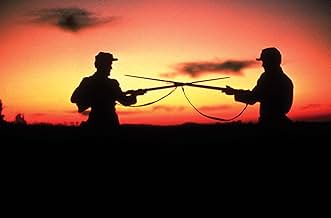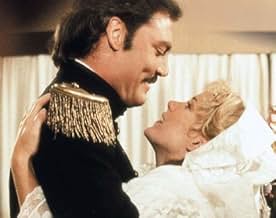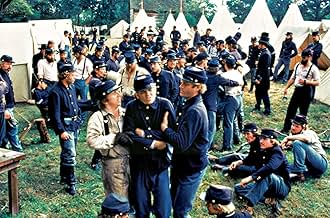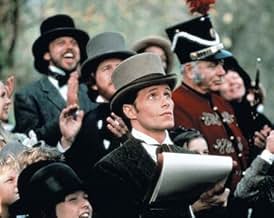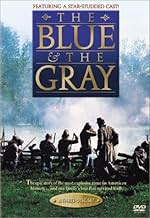America just before and during the Civil War, as seen through the eyes of an artist correspondent.America just before and during the Civil War, as seen through the eyes of an artist correspondent.America just before and during the Civil War, as seen through the eyes of an artist correspondent.
- Nominated for 4 Primetime Emmys
- 2 wins & 4 nominations total
Browse episodes
Featured reviews
I'm not going to nitpick this film because the wrong number of buttons are on a Civil War jacket nor am I going to criticize the fact that certain battles are presented out of chronological sequence, as some others have already pointed out.
But taken as a Civil War drama, THE BLUE AND THE GRAY ranks with the very best movies made about this era of American history and all of the performances are splendid. The human drama, both on the home front before the war and during the various battles, is portrayed very realistically, as are the graphic battle scenes.
The cast assembled does a wonderful job with characters that come alive. GREGORY PECK does well as Abraham Lincoln, although his make-up is a bit disconcerting and he was a bit too mature to play the role in the first place. But STACY KEACH and JOHN HAMMOND carry much of the film as the two leading characters who witness various aspects of the Civil War, seen through their eyes and experiences, and they are excellent.
The supporting cast includes vivid performances from LLOYD BRIDGES, COLLEEN DEWHURST, RORY CALHOUN, GERALDINE PAGE, RIP TORN, STERLING HAYDEN, DIANE BAKER. BRIAN KERWIN is excellent as the Hale brother facing battle for the first time, and the sequence with the balloon to observe the enemy from the air is full of tight suspense.
It may not be a perfect history lesson, but it is photographed beautifully in color (all of it filmed in Arkansas), has a fine musical score and is well worth the time it takes to unwind a very compelling story with characters any viewer can relate to.
I consider it one of the finest made-for-TV miniseries ever made.
But taken as a Civil War drama, THE BLUE AND THE GRAY ranks with the very best movies made about this era of American history and all of the performances are splendid. The human drama, both on the home front before the war and during the various battles, is portrayed very realistically, as are the graphic battle scenes.
The cast assembled does a wonderful job with characters that come alive. GREGORY PECK does well as Abraham Lincoln, although his make-up is a bit disconcerting and he was a bit too mature to play the role in the first place. But STACY KEACH and JOHN HAMMOND carry much of the film as the two leading characters who witness various aspects of the Civil War, seen through their eyes and experiences, and they are excellent.
The supporting cast includes vivid performances from LLOYD BRIDGES, COLLEEN DEWHURST, RORY CALHOUN, GERALDINE PAGE, RIP TORN, STERLING HAYDEN, DIANE BAKER. BRIAN KERWIN is excellent as the Hale brother facing battle for the first time, and the sequence with the balloon to observe the enemy from the air is full of tight suspense.
It may not be a perfect history lesson, but it is photographed beautifully in color (all of it filmed in Arkansas), has a fine musical score and is well worth the time it takes to unwind a very compelling story with characters any viewer can relate to.
I consider it one of the finest made-for-TV miniseries ever made.
Back in the early Sixties there was a short lived television series called The Americans about two brothers who after their father was killed decided to fight on opposite sides in the Civil War. The whole business about brother against brother was no exaggeration. Right up to the very top with Mary Todd Lincoln having relatives who fought for the Confederacy, families were torn apart. The Blue And The Gray brings that aspect of the Civil War better than any other film made for the big or small screen since The Americans.
The families are the Geysers and the Hales related by the mothers, Diane Baker and Colleen Dewhurst being sisters. The Hales are from Gettysburg, Pennsylvania and the Geysers from what would now be West Virginia in and around Harper's Ferry and that's not even 100 miles distance. But the families are true to the sectional divide.
With the exception of John Geyser played by John Hammond who has made a black friend, a free man played by Paul Winfield who gets lynched for helping runaway slaves. He won't fight for a section that espouses slavery as a cause, but won't enlist in the Northern Armies either. A passing acquaintance played by Stacy Keach who gets himself involved in a lot of the major events of the war and married into the Hale family with Julia Duffy persuades Hammond to become a war correspondent and put his artistic talents to good use. Hammond becomes a pictorial chronicler of the seminal event of his generation.
Without ever losing control of the main story lines, what happens to the various Geyser and Hale family members, The Blue And The Gray captures the sweep and pageantry of the Civil War. Such real characters as Abraham Lincoln played by Gregory Peck and John Brown played by Sterling Hayden in what was his farewell performance do take a life of their own. With Peck we see a public and a private Lincoln which is true to the Lincoln mythology and yet quite a human character.
If I had to single out one performance that was especially touching it would be that of David W. Harper as one of the Hale brothers. The young man was eager to be the first to enlist in his town of Gettysburg, but he never made it to the battle that town became famous for. A not well covered portion of the war was the lack of sanitary facilities in army camps. Young Harper falls victim to dysentery and his performance will move you.
A few years later North and South covered a lot of the same ground that this particular mini-series did and it was as well done as The Blue And The Gray. I would recommend them both highly especially for young audiences to gain a real understanding of what the Civil War meant to the average individual/
The families are the Geysers and the Hales related by the mothers, Diane Baker and Colleen Dewhurst being sisters. The Hales are from Gettysburg, Pennsylvania and the Geysers from what would now be West Virginia in and around Harper's Ferry and that's not even 100 miles distance. But the families are true to the sectional divide.
With the exception of John Geyser played by John Hammond who has made a black friend, a free man played by Paul Winfield who gets lynched for helping runaway slaves. He won't fight for a section that espouses slavery as a cause, but won't enlist in the Northern Armies either. A passing acquaintance played by Stacy Keach who gets himself involved in a lot of the major events of the war and married into the Hale family with Julia Duffy persuades Hammond to become a war correspondent and put his artistic talents to good use. Hammond becomes a pictorial chronicler of the seminal event of his generation.
Without ever losing control of the main story lines, what happens to the various Geyser and Hale family members, The Blue And The Gray captures the sweep and pageantry of the Civil War. Such real characters as Abraham Lincoln played by Gregory Peck and John Brown played by Sterling Hayden in what was his farewell performance do take a life of their own. With Peck we see a public and a private Lincoln which is true to the Lincoln mythology and yet quite a human character.
If I had to single out one performance that was especially touching it would be that of David W. Harper as one of the Hale brothers. The young man was eager to be the first to enlist in his town of Gettysburg, but he never made it to the battle that town became famous for. A not well covered portion of the war was the lack of sanitary facilities in army camps. Young Harper falls victim to dysentery and his performance will move you.
A few years later North and South covered a lot of the same ground that this particular mini-series did and it was as well done as The Blue And The Gray. I would recommend them both highly especially for young audiences to gain a real understanding of what the Civil War meant to the average individual/
`The Blue and The Gray' is not a story about the Civil War. It is a long drama about a family set at the time of that war. Running more than six hours, it is indeed long. Yet, anyone interested in human relationships will find that the time is well spent and that no dead points exist. The snippets of the Civil War form a focus for the story and explain some of the relationship issues. They also remind the viewer what a truly difficult time it was for families and for our nation.
Released in 1982 and directed by Andrew V. McLaglen, "The Blue and the Gray" covers the Civil War era from 1859-1865 focusing on two related families: The Geysers, farmers from Charlottesville, Virginia, and the Hales from Gettysburg, Pennsylvania, who own a newspaper. John Geyser (John Hammond) leaves Virginia to get a job as a sketch artist at the Hale's newspaper in Gettysburg. When war breaks out after the Southern states secede from the Union, John covers the war for Harper's Weekly.
MAIN CAST includes Stacy Keach as a Pinkerton-turned-Union-officer who romances John's cousin (Julia Duffy); Gregory Peck as Lincoln; Kathleen Beller as an aristocrat-turned-nurse; Dan Shor & Michael Horton as John's brother; Rip Torn as General Grant; and Lloyd Bridges & Colleen Dewhurst as Mr. and Mrs. Geyser. These are just the principle characters; there are scores of others (Robert Vaughn, Geraldine Page, Warren Oates, Robert Symonds, etc.).
I prefer "The Blue and the Gray" to the similar "North and South" (Books I & II, 1985-86) because it's more streamlined and less soap opera-y. Director McLaglen had decades of experience by this this time with both TV shows and films, including a few notable Westerns, like "Bandolero!" (1968) and "Chisum" (1970); in fact, his "Shenandoah" (1965) was a Civil War 'Western.'
The first half is great, but the second half flounders a bit and includes some cheesy plot gimmicks, like the mad slasher Confederate officer and John mistaking his babe (the nurse) supposedly making out with the Union stud (Keach). The 'floundering' includes some abrupt shifts, like from the Battle of Vicksburg (July, 1863) to the Battle of the Wilderness (May, 1864), which can likely be explained by cuts from the original mini-series. If you watch the longer version you probably won't encounter this problem.
What I like best about this "miniseries" (i.e. long movie) is that, despite some elements of TV-production cheese (e.g. the two Union & Confederate deserters' almost goofy meeting in the woods), the film takes you back in time to the Civil War era and provides a quality picture of what it was like.
Some of the notable events covered include: The Battle of Bull Run, Army camp life, dysentery in the camps, cowards in battle and the branding thereof, balloon reconnaissance, fraternizing with the enemy after hours, brother vs. brother, the Gettysburg Address, the siege of Vicksburg and the desperation thereof (e.g. the Caves), prisoner-of-war camps (Elmira), Lee's surrender and Lincoln's death. Yes, some key events are off-screen (e.g. the Battle of Gettysburg and Lincoln getting shot), but that's the nature of the beast with a TV-budget and an overview-styled story. Lastly, Keach shines as one of the main protagonists, easily one of his best rolls, and Duffy is a delight.
The film runs 296 minutes (4 minutes shy of 5 hours), with the original 3-part miniseries running 381 minutes. It was shot entirely in Arkansas (Fort Smith, Eureka Springs, Fayetteville, Van Buren & Prairie Grove Battlefield State Park). The script was written by John Leekley & Ian McLellan Hunter based on Bruce Catton's material.
GRADE: B
MAIN CAST includes Stacy Keach as a Pinkerton-turned-Union-officer who romances John's cousin (Julia Duffy); Gregory Peck as Lincoln; Kathleen Beller as an aristocrat-turned-nurse; Dan Shor & Michael Horton as John's brother; Rip Torn as General Grant; and Lloyd Bridges & Colleen Dewhurst as Mr. and Mrs. Geyser. These are just the principle characters; there are scores of others (Robert Vaughn, Geraldine Page, Warren Oates, Robert Symonds, etc.).
I prefer "The Blue and the Gray" to the similar "North and South" (Books I & II, 1985-86) because it's more streamlined and less soap opera-y. Director McLaglen had decades of experience by this this time with both TV shows and films, including a few notable Westerns, like "Bandolero!" (1968) and "Chisum" (1970); in fact, his "Shenandoah" (1965) was a Civil War 'Western.'
The first half is great, but the second half flounders a bit and includes some cheesy plot gimmicks, like the mad slasher Confederate officer and John mistaking his babe (the nurse) supposedly making out with the Union stud (Keach). The 'floundering' includes some abrupt shifts, like from the Battle of Vicksburg (July, 1863) to the Battle of the Wilderness (May, 1864), which can likely be explained by cuts from the original mini-series. If you watch the longer version you probably won't encounter this problem.
What I like best about this "miniseries" (i.e. long movie) is that, despite some elements of TV-production cheese (e.g. the two Union & Confederate deserters' almost goofy meeting in the woods), the film takes you back in time to the Civil War era and provides a quality picture of what it was like.
Some of the notable events covered include: The Battle of Bull Run, Army camp life, dysentery in the camps, cowards in battle and the branding thereof, balloon reconnaissance, fraternizing with the enemy after hours, brother vs. brother, the Gettysburg Address, the siege of Vicksburg and the desperation thereof (e.g. the Caves), prisoner-of-war camps (Elmira), Lee's surrender and Lincoln's death. Yes, some key events are off-screen (e.g. the Battle of Gettysburg and Lincoln getting shot), but that's the nature of the beast with a TV-budget and an overview-styled story. Lastly, Keach shines as one of the main protagonists, easily one of his best rolls, and Duffy is a delight.
The film runs 296 minutes (4 minutes shy of 5 hours), with the original 3-part miniseries running 381 minutes. It was shot entirely in Arkansas (Fort Smith, Eureka Springs, Fayetteville, Van Buren & Prairie Grove Battlefield State Park). The script was written by John Leekley & Ian McLellan Hunter based on Bruce Catton's material.
GRADE: B
I did not see this movie when it was shown as a mini-series.I happened to like this movie because it gave a simple portrayal of what it might have been like to be a family during this period and having to face the problem of a family that was divided in its loyalties . I thought the makers of this movie followed the history of the period and gave a good presentation of the issues that the people had to deal with at the time. Of course it cannot compare to the recent Civil War Movies or even the Ken Burns series . Given the time that it was made I think it was a good portrayal of the period.
My only fault with the movie was the fact that it seemed to put the fall of Vicksburg after the Gettysburg Address. I did not understand how this was allowed to happen given the fact that it seemed to be based on Bruce Catton's work. Can anyone explain this?
My only fault with the movie was the fact that it seemed to put the fall of Vicksburg after the Gettysburg Address. I did not understand how this was allowed to happen given the fact that it seemed to be based on Bruce Catton's work. Can anyone explain this?
Did you know
- TriviaSome filming took place at Prairie Grove Battlefield State Park in Arkansas. The film crew built a false side onto a historic building there, then blew it off for a special effect, assuring the State park officials that no harm would come to the building. The explosion was larger than promised, damaging the historic house's structure.
- GoofsWhen John Brown is hanged for the uprising at Harper's Ferry, the apple trees are in full blossom. John Brown was hanged on 2 December 1859.
- Quotes
Abraham Lincoln: It's well known that the more a man speaks, the less he's understood.
- ConnectionsReferenced in Saturday Night Live: Drew Barrymore/Squeeze (1982)
- SoundtracksRock of Ages
Lyrics by Augustus Montague Toplady (as Augustus M. Toplady)
Music by Thomas Hastings
- How many seasons does The Blue and the Gray have?Powered by Alexa
Details
Contribute to this page
Suggest an edit or add missing content




